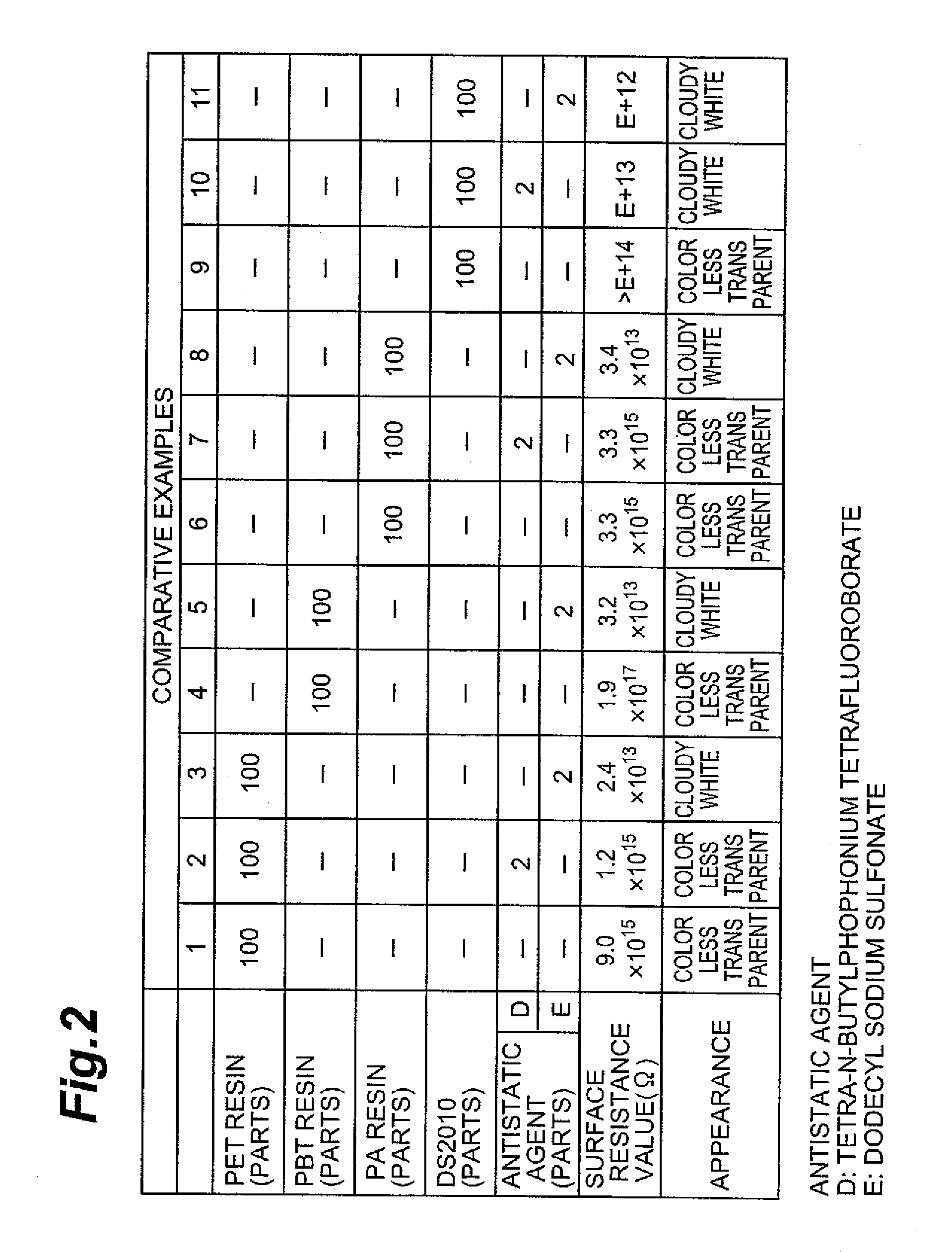Antistatic agents for resins, antistatic resin compositions, and antistatic resin molded products
a technology of antistatic agents and resins, applied in the direction of nanotechnology, other chemical processes, nanotechnology, etc., can solve the problems of resin and inability to use, resin and inability to resist static electricity damage, color becomes non-transparent white, etc., to achieve superior antistatic characteristics, reduce the transparency of resins hardly, and improve the effect of antistatic characteristics
- Summary
- Abstract
- Description
- Claims
- Application Information
AI Technical Summary
Benefits of technology
Problems solved by technology
Method used
Image
Examples
manufacturing example 1
[0096]1783 g (1.924 mol) of tri-n-butyl-n-hexadecylphosphonium chloride 50% aqueous solution (manufactured by Nippon Chemical Industrial, Co., Ltd.) was diluted with 9 L of ion-exchanged water. 222.0 g (2.024 mol) of sodium fluoroborate (manufactured by Morita Chemical Industries, Co.) was dissolved in 1 L of ion-exchanged water, and after filtering the undissolved component with filter paper, this was titrated into the phosphonium salt aqueous solution at room temperature (15° C.). After titration was complete, this was allowed to mature for 60 minutes at room temperature (25° C.).
[0097]Next, the slurry obtained was filtered by centrifugal separation. Six liters of ion-exchanged water was added to the crystals obtained after filtering; this was agitated for 15 minutes at room temperature, and was again filtered by centrifuge. The filter solution was analyzed by titrating with silver nitrate aqueous solution, and the slurry was rinsed and re-filtered repeatedly unt...
manufacturing example 2
[0099]The same procedures as in Manufacturing Example 1 were conducted using 178.3 g (0.192 mol) of tri-n-butyl-n-tetradecylphosphonium chloride 50% aqueous solution (manufactured by Nippon Chemical Industrial, Co., Ltd.) and 22.20 g (0.202 mol) of sodium fluoroborate (manufactured by Morita Chemical Industries, Co.), and tri-n-butyl-n-tetradecylphosphonium tetrafluoroborate was obtained.
Melting point: 53° C. (melting point measuring apparatus using light transmission method).
Decomposition temperature: 423° C. (TG-DTA)
Halogen content: 78 ppm (silver nitrate titration)
Residual water content: 0.18% (Carl Fischer hygrometer)
manufacturing example 3
[0100]The same procedures as in Manufacturing Example 1 were conducted using 2779.3 g (3.0 mol) of tri-n-butyl-n-hexadecylphosphonium chloride 50% aqueous solution and 579.8 g (3.15 mol) of potassium hexafluorophosphate instead of sodium fluoroborate, and tri-n-butyl-n-hexadecylphosphonium hexafluorophosphate was obtained.
Melting point: 50.0° C. (melting point measuring apparatus using light transmission method).
Decomposition temperature: 369.7° C. (TG-DTA)
Halogen content: 89 ppm (silver nitrate titration)
Residual water content: 0.21% (Carl Fischer hygrometer)
PUM
| Property | Measurement | Unit |
|---|---|---|
| mean particle size | aaaaa | aaaaa |
| mean particle size | aaaaa | aaaaa |
| mean particle size | aaaaa | aaaaa |
Abstract
Description
Claims
Application Information
 Login to View More
Login to View More - R&D
- Intellectual Property
- Life Sciences
- Materials
- Tech Scout
- Unparalleled Data Quality
- Higher Quality Content
- 60% Fewer Hallucinations
Browse by: Latest US Patents, China's latest patents, Technical Efficacy Thesaurus, Application Domain, Technology Topic, Popular Technical Reports.
© 2025 PatSnap. All rights reserved.Legal|Privacy policy|Modern Slavery Act Transparency Statement|Sitemap|About US| Contact US: help@patsnap.com



